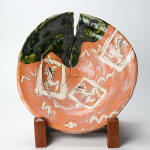Suzuki Goro 鈴木五郎 Japanese, b. 1941
H8.8 × W34.5 × D33.6 cm
Further images
-
(View a larger image of thumbnail 1
)

-
(View a larger image of thumbnail 2
)

-
(View a larger image of thumbnail 3
)

-
(View a larger image of thumbnail 4
)

-
(View a larger image of thumbnail 5
)

-
(View a larger image of thumbnail 6
)

-
(View a larger image of thumbnail 7
)

-
(View a larger image of thumbnail 8
)

-
(View a larger image of thumbnail 9
)

-
(View a larger image of thumbnail 10
)

-
(View a larger image of thumbnail 11
)

-
(View a larger image of thumbnail 12
)

-
(View a larger image of thumbnail 13
)

-
(View a larger image of thumbnail 14
)

This striking ceramic piece by Suzuki exemplifies a contemporary and original take on traditional Oribe ware, a distinct style of Japanese ceramics that originated in the Mino region in the 17th century. Recognizable for its characteristic lively geometric and organic designs, Oribe ware often features a burnt orange background with areas of vibrant green glaze. Suzuki’s plate embodies the Wabi-Sabi aesthetic, celebrating beauty in imperfection, as seen in the large kiln-firing crack that naturally bisects the piece. Six gentle jagged lines are drawn across the surface, adding texture and dimension to the design. Playful depictions of nude figures, inspired by Henri Matisse’s modernist abstract and figurative works, appear within the composition, blending traditional Japanese techniques with a contemporary sensibility. The iconic Oribe green glaze is brushed onto the upper left, pooling in rich, variegated hues that add a touch of whimsy to the piece.













